Panicle Hydrangeas In Early September. On September 4th I took a tour of Poison Ivy Acres, photographing every panicle hydrangea that was in flower for this post. What is a panicle hydrangea? These are shrubs that are in the genus Hydrangea and the species paniculata. This group of hydrangeas are popular because they are very hardy (into a Zone 4, meaning they will live in places where the temperatures drop to -30 Fahrenheit.) and can even do well into some hotter, Zone 9 regions. Because these hydrangeas set flowers on the new growth each year, they will bloom even after a hard winter or pruning them back in fall or spring. (Note: summer pruning, whether done by people or deer, will remove the flowers for that season.) The other reason to grow these shrubs is the long period of flowering. In my gardens on Cape Cod, panicle hydrangeas come into bloom in July (early or late according to variety) and remain in flower into October.
Planting and Care of Hydrangea paniculata. Panicle hydrangeas grow well in full sun to part sun, and they aren’t as thirsty as the macrophyllas (mopheads and lacecaps). A deep soaking once a week if it hasn’t rained is perfect for this group of plants.
Pruning Panicle Hydrangeas. I do not try and control the size on my panicle hydrangeas, although I do occasionally cut some back by half, or prune selected stems down to a foot or two from the ground in the spring. Like all pruning, this stimulates new growth, and the plants quickly get to be just as large, but I might prune them hard not as a way to make them shorter but to improve their shape or help create bushier growth. The main pruning I do on these shrubs is, before the leaves come out in the spring, is first to remove any stems that are headed into the center of the plant, and after that to look for rubbing, crossed branches and to take one of those away. After that I might shorten a stem or two knowing that where I make those “heading cuts” the growth will double.
Here are the photos I took on the 4th, with notes about these varieties in the captions.
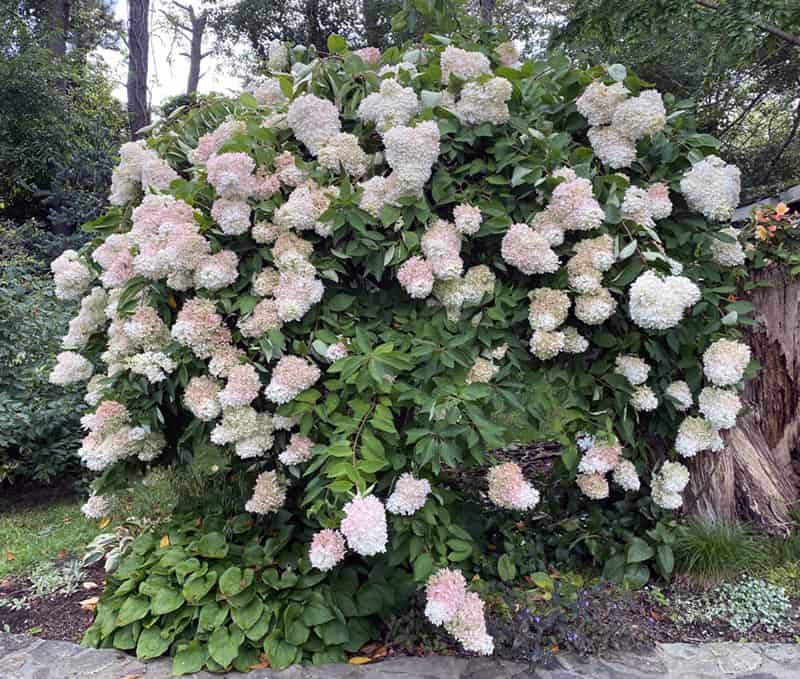
This is a grafted tree-form of Hydrangea paniculata ‘Grandiflora.’ It is the long-loved “PG” hydrangea. Some hydrangea trees are created by letting the plants grow tall and then selecting for the most upright stems, removing the lower ones from the ground up. (See the Pinky Winky below for an example of this method.) Several years ago that was the way “hydrangea trees” were formed. Now you can buy grafted hydrangeas that are already on a single trunk that is four to six feet tall. Note that these single trunks don’t grow any taller, but the stems on top of that trunk will grow up and out. This PG tree form has been on my property for 10 years. It is about ten feet tall and twelve feet wide. The flowers get to be a medium pink in the fall.
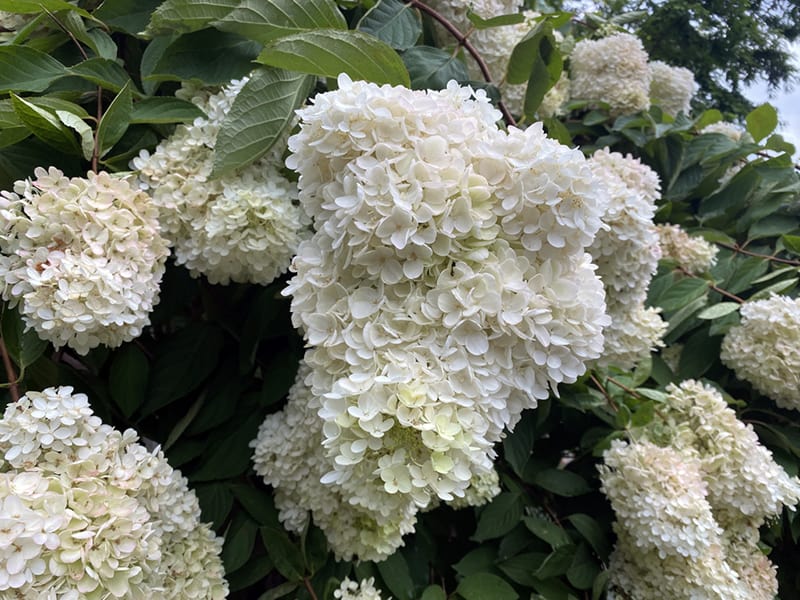
Flowers on the Grandiflora variety are huge and many of them look like bears! See the “nose and ears” on this one? When the flowers grow so large they bend the branches down so that when a Grandiflora is grown in tree form it looks a bit like a weeping tree. The flowers are larger than a human head, and of course they are heavier after it rains. I do not stake or support these.
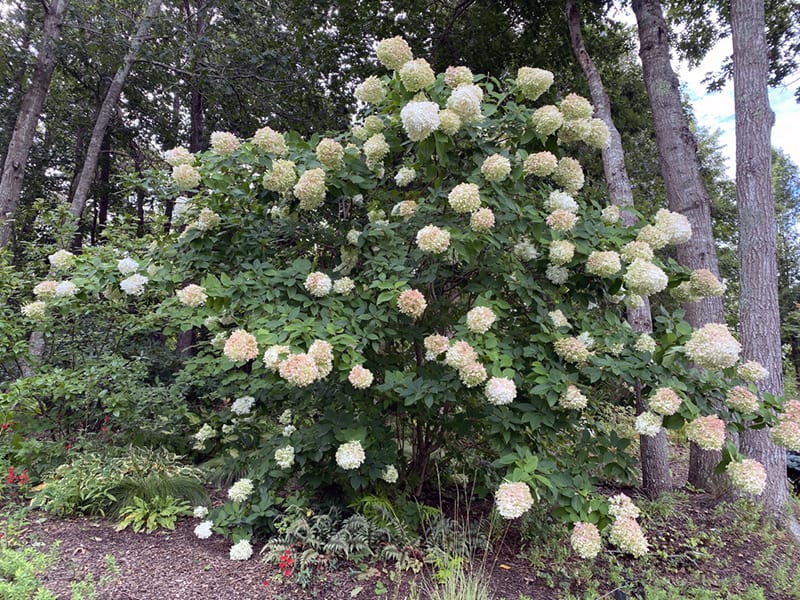
This is my Limelight hydrangea. It is planted in morning shade and afternoon sun, from about 2 PM on. The flowers on this shrub are a bit smaller than on other Limelights because I do not fertilize and this plant is growing where there is competition from the tree roots. Also, this shrub only gets watered deeply once a week if it doesn’t rain. This shrub has been in this location for ten years – it was three feet tall when I planted it, and now it’s eight feet tall and ten to twelve feet wide. I am considering pruning this into a multi-stemmed tree form next spring.

This is Little Lime hydrangea. It is similar to Lime Light but stays a bit smaller, although it’s still a good-sized shrub. This has been in this location for 11 years. It used to be in afternoon shade, but it’s now in full sun. My Little Lime is 5 feet tall and eight feet wide.
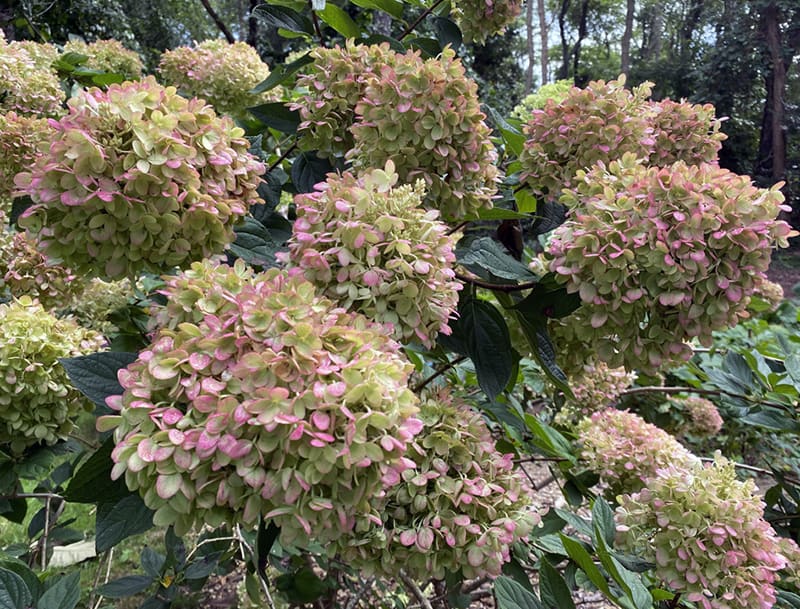
When hydrangea flowers start to change color as they age, we call this “the antique phase.” Some panicles turn tan, others pink, and some take on a variety of colors from pink to green. This is Little Lime sporting the antique flowers in early September. You can cut these and they usually dry very successfully at this stage of bloom.
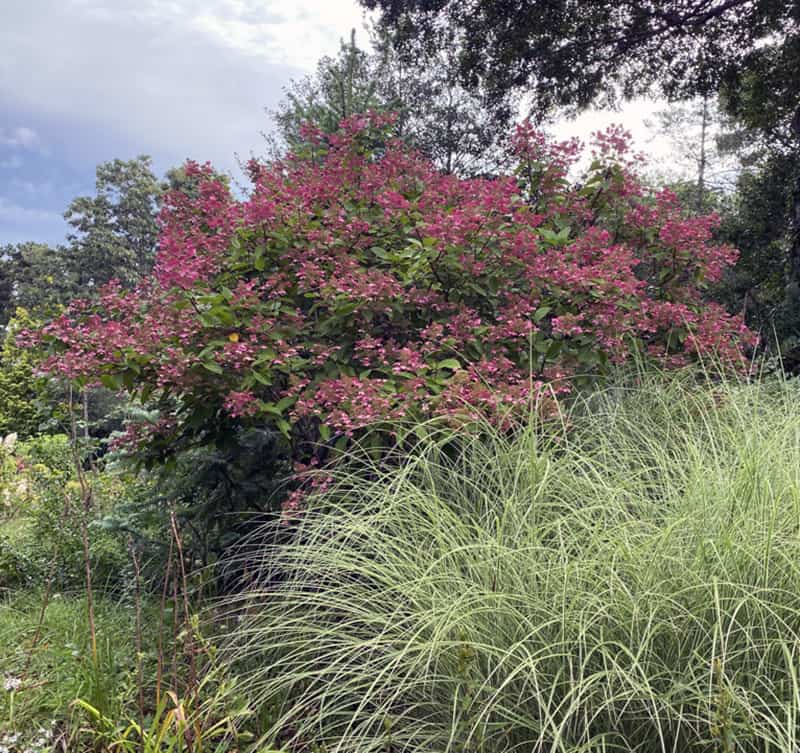
Quick Fire lives up to its name by coming into flower sooner than many panicle types, This one, the original Quick Fire, is also fast growing and takes on the pink color in August. Quick Fire is a good hydrangea to use as part of a privacy border because it grows rapidly and gets large. I’ve had this plant for eight years but I moved it to this location five years ago because it was clear that it would be too large in the first place I planted it. Now this hydrangea is about eight feet tall and wide. It may become a “tree form” on its own here…I have no reason to try and make it smaller.
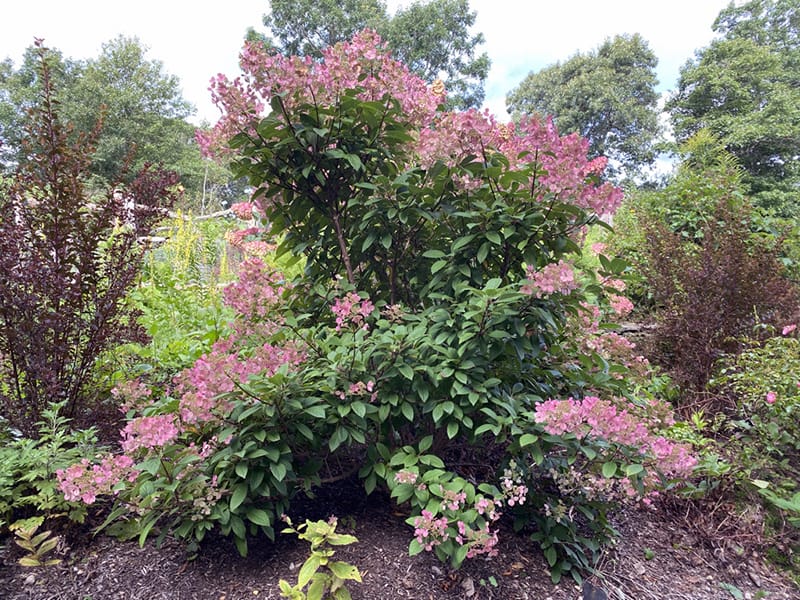
This panicle is Little Quick Fire. Like the larger version, it is in bloom a full three weeks earlier than many panicles…this has white flowers the first week in July in my gardens on Cape Cod. The blooms turn pink in August. I haven’t done much shaping of this plant in the six years I’ve grown it here, and it shows! It will get pruned next spring so I can shape it and let it fill in to be a bit more bushy and rounded. This plant is four feet tall and equally as wide.

Speaking of hydrangeas that color up quickly and brightly, meet Fire Light. This plant is only five years old, and it was quite small when I got it. This Fire Light is now about five feet tall and wide. It comes into bloom with white flowers in early July in the Northeast, and the pink color develops in August. I love how brilliant pink it becomes, and as we go into September these flowers turn a deep wine pink in color. Note the rounded, bushy habit of this panicle; I have done little pruning and shaping of this plant and it looks full all on its own. This Fire Light is growing in full sun and it only gets watered every couple of weeks if it hasn’t rained. The flowers are smaller than Lime Light and the PG, and the stems are fairly sturdy.
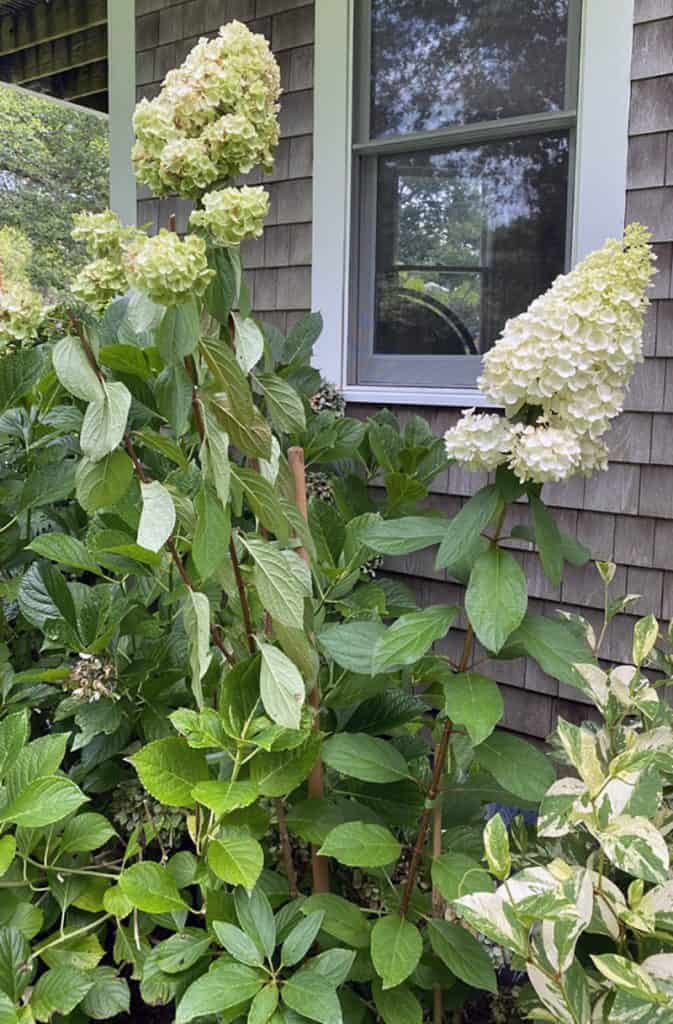
In the huge-flower department, I am growing Lavalamp Moonrock. The flowers are long and large, starting out green and then turning white. This is a young plant, only four years in my yard, and I staked it this year to keep these huge flowers from falling on the lawn. My guess is that I will be training this into tree form as well. I have this planted where it gets about four hours of afternoon sun. (The variegated plant on the right is Persicaria virginiana ‘Variegata’ – not Painter’s Palette – and the hydrangea on the left is Forever and Ever Peppermint, a macrophylla.)

I planted Candy Apple, a short paniculata (so far) in my front perennial garden in full sun. The flowers start out greenish, then turn white and in the fall take on a pinkish, caramel color. I like how this looks with my Elevate marigolds, grown from seeds that I buy from Burpee every spring. It makes a good looking fall garden, with yellow Profusion zinnias.

I have great hopes for this smaller panicle variety. I have only had it for two years, and so far it’s about 2 feet tall and wide. This is Fire Light Tidbit. I’m hoping that it stays under three feet tall, but we’ll see…shrubs have a way of continuing to grow past their “projected height and width,” don’t they? I have Fire Light Tidbit planted where it gets afternoon sun. So far the color isn’t as brilliant as the larger, Fire Light, but it didn’t start to color up as soon as the bigger shrub.
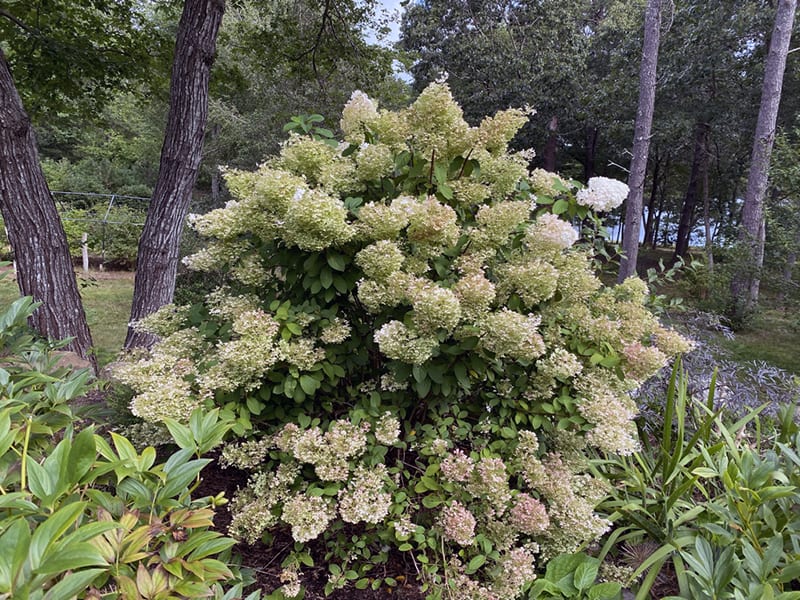
Bobo is one of the panicles that was estimated to stay under four feet tall and wide. This one has been in this location for 7 years and it’s five feet tall and almost as wide this summer. A lovely plant, but not small. I’ll prune it down by about a third next spring, but I expect that it will reach the same size by the end of next summer. Bobo doesn’t get very pink in the fall, but has that same antique greenish/tan like Little Lime.
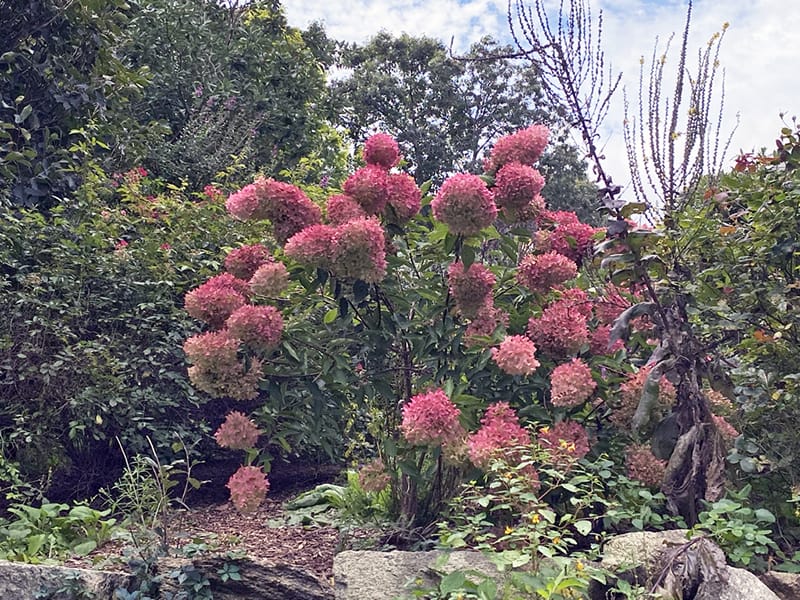
I don’t know why Zinfin Doll isn’t planted more often. Wow! What a great panicle hydrangea. Big flowers, naturally round shape and very stem sturdy…those huge flowers are well supported, even after a rain. Nice, vivid pink color that starts in August. This plant is 8 years old and has grown from a tiny shrub in a 4″ pot to just over 4 feet tall and wide in that time. I have it in a location where it can grow large and even into a tree form if necessary. A pretty, sturdy and naturally well-shaped shrub. I know that the dead Verbascum olympicum kind of takes away from the look of the hydrangea, but I wanted it to go to seed in this location.
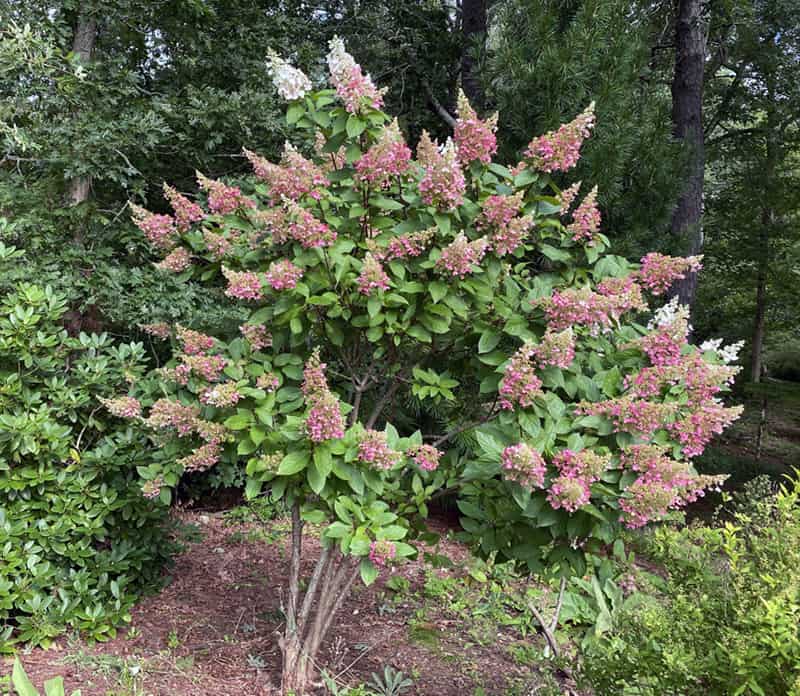
And the last one I have to show you today is Pinky Winky. This has naturally taken on a tree form. I prune the old flowers off in the spring and remove crossed branches and those headed into the plant, but otherwise I don’t try and control it. Pinky Winky is a bit more upright in growth habit than many panicles. It would be a good plant for a shrub border, off a corner of the house (plant six feet from the corner) or in the back of a perennial garden. The flowers start out white in early August and then turn pink from the bottom up, giving the blooms a two-tone look for a good month before they turn all pink. I have this Pinky Winky in part shade (maybe three or four hours of direct sun in mid-day) and it has been in this spot for 12 years. When I got this plant it was six inches tall and growing in a 4″ pot, so you can see that it has grown a bit less than a foot a year taller. This plant is about 9 feet tall and six feet wide.
I have more panicle varieties that are babies now…so stay tuned for more!

You have some beautiful hydrangeas, your limelight looks gorgeous, I have 2 that got beaten down by heavy rains this year, several of the branches snapped right off because the blooms were so heavy. It was very disheartening because the shrubs were huge with beautiful big blooms.
Hello
I really enjoyed your article. I love these hydrangeas. But I am in Malawi, where can I buy these flowers online, a reliable site that will send me what I have ordered.
Regards
I have not idea who will ship Hydrangeas to Malawi. Sorry I can’t help.
Love this. I have new yard this year and decided to stray away from my “just endless summers” (though I did buy 5 of these. Love your comments bc I have some of the same…. Pinky winky….. firelight tidbit…. I think my quick fires are quick fire fab…. Little lime…. Limelight….Annabelle…. Blue wave lace cap (never done lace cap before!) …. And my most exciting addition is a cutting from my grandfathers hydrangea we had at his Cape house- all 7 grandkids got a piece so I’m excited to have in my yard. Thanks for listening lol!!!!!